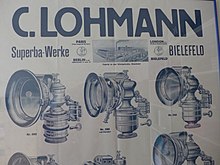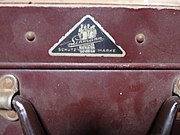Lohmann works
The origins of Lohmann Werke AG go back to the company C. Lohmann Cie. Founded by Carl Lohmann (1853–1916) in London in 1892 . Carl Lohmann came from an old business family from Bielefeld who ran a large bleaching and dyeing factory in the Gadderbaum district. The Dr. August Oetker . The youngest daughter of the family, Else Lohmann , was an expressionist painter. The Lohmann engine was later sold with the subsidiary Lohmann Motoren Werke, based in Hamburg.
history
The company initially dealt with the trade and export of bicycle parts and saddles in London. In 1895 a new location in Bielefeld (old steam mill) was put into operation in order to sell English imports with exclusive sales rights. After a fire, a new factory was built in Königstrasse (today's Walther-Rathenau-Strasse) and put into operation in 1904. Independent products were now produced and sold here. From then on, the company developed into one of the leading manufacturers of bicycle parts on the European continent. After the death of the company founder Carl Lohmann in 1916, the Lohmann works were converted into a family-owned stock corporation. The number of employees rose to 1550 by 1945, the most prominent of whom was once Carl Severing (Prussian Minister of the Interior from 1928 to 1932). In addition to the head office in London and the factory in Bielefeld, a production facility was set up in Pretoria in South Africa and one in Pabianice near Łódź in Poland in the 1930s and 1940s, but these were lost after the war.
On September 30, 1944, large parts of the factory were destroyed in a terrible attack on Bielefeld. Then Adolf Lohmann (the founder's eldest son) and many of his employees campaigned for the reconstruction. A dismantling by the victorious powers could be prevented by close contact with the military government.
In 1947, together with the inventor Hermann Teegen, the company developed the world's first auxiliary bicycle motor, which made it necessary for the cyclist to pedal. In the 1960s, after the death of A. Lohmann, the company was finally sold to the company Hanning und Kahl in Bielefeld after numerous bank transactions.
The new owners continued some of the production processes under the old name, later in the buildings of the former Lepper company, Bielefeld, Königsbrügge. On this Lohmann-Werke site, a development plan area was created on which, by resolution of the district council of June 14, 2018, a street was named "Else-Lohmann-Straße". Today the company with the Lohmann brand is no longer on the market.
Products
Bicycle saddles
The leather bicycle saddles in particular were, alongside the Brooks brand , the most widely produced leather saddles in the world until the Second World War .
Suitcase production
The leather processing led to the construction of a new production line for the travel case production from 1906. Here Lohmann-Werke produced both high-quality leather suitcases as well as inexpensive “ vulcanized fiber suitcases” and large-sized steamer suitcases. The stability was demonstrated by the logo with the five saddlers on the tubular plate case.
Vehicle lamps
In addition, the production of vehicle lamps (oil lanterns and later dynamo-operated electric lamps) began. They were mounted on bicycles as well as on the new automobiles.
Lohmann Motor (auxiliary bicycle motor)
In 1948 the Lohmann engine was the first auxiliary bicycle engine after the war that was powered by a compression-ignition principle. It could process different fuels, but was mostly operated with petroleum from the drugstore. His concept was to let the driver pedal along on challenging terrain. He delivered his power directly to the rear wheel with a friction roller. This made him the pioneer of today's pedelecs . The engine principle was based on a changeable liner that could vary the compression in the combustion chamber. This principle is z. Currently also used in the new Nissen models with the designation VC-T. The engine caused a sensation back then and was u. a. Exhibited for some time in the Deutsches Museum, Munich as the world's smallest vehicle engine. In addition, articles about the Lohmann engine appeared in the Guinness Book of Records .
Picture gallery
literature
- Lohmann Werke AG. Development of an important industry in the Ravensberger Land. Edited on the occasion of the 60th anniversary of Lohmann Werke AG. Bielefeld on January 1, 1942 ( title recorded by the City Archives and State History Library Bielefeld).
- Reinhard Vogelsang: From the beginning to the middle of the 19th century (= history of the city of Bielefeld . Volume 1 ). 1st edition. Winkel, Bielefeld 1980, ISBN 3-88049-128-3 .
- Guinness Book of Records . 1982, ISBN 3-550-07705-X , pp. 165, 169.
Web links
- Klaus-Peter Hellemann: Lohmann-Motoren-Werke. In: lohmann-motoren-werke.de (private website)
Individual evidence
- ↑ Christina Wittler: Late recognition . The painter Else Lohmann (1897–1984). In: Bärbel Sunderbrink (Ed.): Women in Bielefelder History . Publishing house for regional history, Bielefeld 2010, ISBN 978-3-89534-795-5 , p. 233-240 .
- ↑ Else Lohmann. Resume. (PDF; 238 kB) in the Westphalian History portal.
- ↑ Adalbert Wichert: The text for the photo. To understand photo-text relationships . In: Alfred Holzbrecher u. a. (Ed.): Photo + Text . Handbook for educational work. VS, Verlag für Sozialwissenschaften, Wiesbaden 2006, ISBN 3-531-14928-8 , p. 25–38 (cited therein: Adolf Lohmann: Jubiläumsschrift 1882–1942 Lohmann Werke AG. W. Eilers jr., Bielefeld 1942. No. 1).
- ↑ Archives. Corporate fonts. In: deutsches-museum.de, accessed on August 31, 2019.
- ↑ Guinness Book of Records. 1982, ISBN 3-550-07705-X , pp. 165, 169, and 1983, ISBN 3-550-07712-2 , p. 174.







